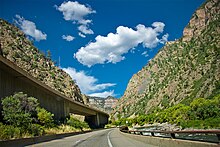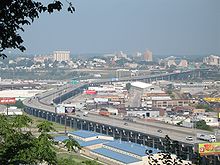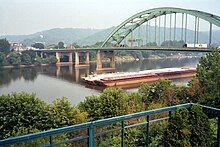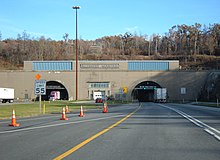Interstate 70
I-70 approximately traces the path of U.S. Route 40 (US 40; the old National Road) east of the Rocky Mountains. West of the Rocky Mountains, the route of I-70 was derived from multiple sources. The Interstate runs through or near many major U.S. cities, including Denver, Topeka, Kansas City, St. Louis, Indianapolis, Columbus, Pittsburgh, and Baltimore. The sections of the Interstate in Missouri and Kansas have laid claim to be the first Interstate in the United States. The Federal Highway Administration (FHWA) has claimed the section of I-70 through Glenwood Canyon in Colorado, completed in 1992, to be the last piece of the Interstate Highway System, as originally planned, to open to traffic.
The construction of I-70 in Colorado and Utah is considered an engineering marvel, as the route passes through the Eisenhower Tunnel, Glenwood Canyon, and the San Rafael Swell. The Eisenhower Tunnel is the highest point along the Interstate Highway System, with an elevation of 11,158 feet (3,401 m).
Route description
| mi | km | |
|---|---|---|
| UT | 231.70 | 372.89 |
| CO | 450.18 | 724.49 |
| KS | 424.15 | 682.60 |
| MO | 250.16 | 402.59 |
| IL | 157.33 | 253.20 |
| IN | 156.60 | 252.02 |
| OH | 225.60 | 363.07 |
| WV | 14.45 | 23.26 |
| PA | 167.92 | 270.24 |
| MD | 93.62 | 150.67 |
| Total | 2,171.71 | 3,495.03 |
Utah
I-70 begins at an interchange with I-15 near Cove Fort. Heading east, I-70 crosses between the Tushar and Pahvant ranges via Clear Creek Canyon and descends into the Sevier Valley, where I-70 serves Richfield, one of two towns of more than a few hundred people along I-70's path in Utah. The second town with more than a few hundred people served by I-70 is Salina. Upon leaving the valley near Salina, I-70 crosses the 7,923-foot (2,415 m) Salina Summit and then crosses a large geologic formation called the San Rafael Swell.

Prior to the construction of I-70, the swell was inaccessible via paved roads and relatively undiscovered. Once this 108-mile (174 km) section was opened to traffic in 1970, it became the longest stretch of Interstate Highway with no services and the first highway in the U.S. built over a completely new route since the Alaska Highway. It also became the longest piece of Interstate Highway to be opened at one time. Although opened in 1970, this section was not formally complete until 1990, when a second steel arch bridge spanning Eagle Canyon was opened to traffic.
Since I-70's construction, the swell has been noted for its desolate beauty. The swell has since been nominated for national park or national monument status on multiple occasions. If the swell is granted this status, it arguably would be the first time a national park owes its existence to an Interstate Highway. Most of the exits in this span are rest areas, brake check areas, and runaway truck ramps with few traditional freeway exits.
I-70 exits the swell near Green River. From Green River to the Colorado state line, I-70 follows the southern edge of the Book Cliffs.
Colorado
Entering from Utah, I-70 descends into the Grand Valley, where it meets the Colorado River, which provides its path up the western slope of the Rocky Mountains. Here, I-70 serves the Grand Junction metropolitan area before traversing more mountainous terrain.

The last section of I-70 to be completed was the 15-mile (24 km) Glenwood Canyon. This stretch was completed in 1992 and was an engineering marvel due to the extremely difficult terrain and narrow space in the canyon, which requires corners that are sharper than normal Interstate standards. Construction was delayed for many years due to environmental concerns. The difficulties in building the road in the canyon were compounded by the fact the Denver and Rio Grande Western Railroad occupied the south bank, and many temporary construction projects took place to keep US 6 open, at the time the only east–west road in the area. Much of the highway is elevated above the Colorado River. The speed limit in this section is 50 mph (80 km/h) due to the limited sight distance and sharp corners.

The Eisenhower Tunnel, the highest vehicular tunnel in North America and the longest tunnel built under the Interstate program, passes through the Continental Divide.

Because of the rugged and narrow terrain of the Rocky Mountains, I-70 is one of few roads connecting Colorado's ski resorts with Denver.
Descending through the eastern foothills of the Rocky Mountains, one can see the Denver skyline on a clear day. This can fool truckers and other unsuspecting drivers because one must still traverse 10 miles (16 km) of steep grade road before reaching the city. A series of signs warns truckers of the steep grade. As I-70 leaves the foothills, it goes through Denver and intersects I-25, serving as the central east–west artery through the city. Leaving Denver, I-70 levels out and traverses the wide plains through eastern Colorado. East of Denver, I-70 makes a broad turn to the south-southeast for 30 miles (48 km), before reaching Limon and resuming its eastward journey toward Kansas.
Kansas
Coming from Colorado, I-70 enters the prairie, farmlands, and rolling hills of Kansas. This portion of I-70 was the first segment to start being paved and to be completed in the Interstate Highway System. It is given the nickname "Main Street of Kansas", as the Interstate extends from the western border to the eastern border of the state, covering 424 miles (682 km) and passing through most of the state's principal cities in the process.

In Salina, I-70 intersects with the north terminus of I-135. In Topeka, I-70 intersects I-470, twice. At the eastern intersection, the Kansas Turnpike merges, with I-70 becoming a toll road. This is one of only two sections of I-70 that are tolled. (The other is part of the Pennsylvania Turnpike.) I-70 carries this designation from Topeka to Kansas City, the eastern terminus of the turnpike. About halfway between Topeka and Kansas City, I-70 passes through Lawrence (home to the University of Kansas). The tolled portion of the turnpike ends near Bonner Springs, just west of Kansas City. There is also a third auxiliary route in Topeka, I-335, which runs from I-470 south to meet up with I-35 in the Flint Hills town of Emporia. Just past the Bonner Springs Toll Plaza, I-70 crosses I-435 for the first time, which allows travelers to bypass the downtown traffic via I-435, which encircles the Kansas City metropolitan area. Further down the highway in Kansas City, approximately three miles (4.8 km) before the 18th Street Expressway, I-70 is intersected again by another auxiliary route. This route, I-635, runs from I-35 at its southern terminus up to I-29, just about five miles (8.0 km) across the Missouri River, at its northern terminus. From I-635 to just past the US 169 (7th Street) exit, I-70 runs adjacent Union Pacific Railroad's Armourdale Yard. Here, I-670 (also designated "Alternate 70" on some signs) diverges, providing a more direct route that rejoins I-70 proper a few miles east in Missouri. The highway passes over the former stockyards and railyard when it crosses the Kansas River on the Intercity Viaduct into Downtown Kansas City, Missouri.
Missouri

After crossing the Intercity Viaduct, I-70 enters Missouri. It encounters a loop of freeways, called the Downtown Loop, which contains I-70 as well as I-35, I-670, US 24, US 40, US 71, and US 169. In the southern part of this loop, I-670 cuts directly through the downtown while I-70 bypasses the taller buildings a few blocks north near the Missouri River. Westbound I-670 is also designated Alternate I-70. Most of the Interstates in this loop are in their second mile, so all exits (no matter which Interstate the road carries) are numbered 2 and suffixed with every letter of the alphabet except for I, O, and Z, leading to the loop's nickname, the Alphabet Loop.
The section of I-70 in Downtown Kansas City is approximately the southern city limits of "City of Kansas" when it was incorporated in 1853. The first two auto bridges in Missouri mark the city's original boundaries with the Buck O'Neil Bridge (US 169) being the west boundary while the Heart of America Bridge (Route 9) is the east boundary. Another intersection of note is the second traverse of I-435. This is primarily notable because it immediately precedes the Truman Sports Complex (home of both Arrowhead and Kauffman stadiums) and also because the entrance ramps from I-435 northbound onto I-70 eastbound also serve as the exit ramps from I-70 into the Truman Sports Complex parking lots. This section of the Interstate is marked as the "George Brett Super Highway", named after the Kansas City Royals third-base player who played the entirety of his career (1973–1993) at Kauffman Stadium. The last Interstate intersection in the immediate Kansas City metro area is with I-470 in Independence.
After passing Kansas City, I-70 traverses the length of Missouri, west to east. It passes through the largest city between Kansas City and St. Louis, Columbia, which is about halfway between the two major cities and the home of the University of Missouri. The terrain is rolling with some hills and bluffs near rivers. I-70 also crosses the Missouri River twice (as did the original US 40)—at Rocheport, about 15 miles (24 km) west of Columbia, and at St. Charles, about 20 miles (32 km) northwest of St. Louis. Most of the highway on this stretch is four lanes. Various proposals have been made to widen it (at an estimated cost of $3.5 billion) including turning it into a toll road. I-70 eventually gets into Greater St. Louis, and US 40 splits to the south, along with US 61, which does not have a concurrency with I-70. In late 2009, the intersecting road was upgraded to Interstate standards along with the completion of the overhaul of I-64. After this interchange, I-70 intersects two auxiliary routes, I-270 and I-170. After passing several bedroom communities in north St. Louis County, I-70 enters the city limits of St. Louis. It turns east to cross the Mississippi River on the Stan Musial Veterans Memorial Bridge, connecting with an extension of I-44, which takes the former I-70 route through Downtown St. Louis to meet I-55 at its connection to the Poplar Street Bridge.
The 1985 World Series between the Kansas City Royals and St. Louis Cardinals was nicknamed the "I-70 Series" because St. Louis and Kansas City are the two endpoints of I-70 in Missouri, and the highway passes within sight of both the Royals' Kauffman Stadium and, at the time, the Cardinals' Busch Stadium.
Illinois
After crossing the Stan Musial Veterans Memorial Bridge, I-70 merges with I-55, while I-64 splits off I-55. When the routes intersect I-270, I-55 stays on its own pavement using the mileposts from the Poplar Street Bridge, while I-70 heads east on I-270's pavement using I-270's mileposts. Because of this arrangement, when I-55/I-70 intersects I-270 from the southeast, the exit number is 20 and, in the opposite direction, it is exit 15.
I-70 was rerouted from the Poplar Street Bridge to the Stan Musial Veterans Memorial Bridge north of Downtown St. Louis, which opened in February 2014.
I-70 passes through numerous county seats in Illinois, among them Vandalia, the state capital from 1818 to 1839. It runs concurrently with I-57 around Effingham and then proceeds east toward Indiana.
Indiana

I-70 enters Indiana just to the west of Terre Haute and then crosses the Wabash River before skirting the city's south side. After passing through miles of gently rolling terrain in rural west-central Indiana, the freeway approaches the major Indianapolis metropolitan area.
The main entrance to Indianapolis International Airport was relocated to I-70's exit 68 on November 11, 2008. Upon nearing the central business district of Indiana's capital city, the visages of Lucas Oil Stadium and the JW Marriott Indianapolis hotel, with the city's skyline as their backdrop, now dominate the view to the north from the freeway. After passing just to the south of the world headquarters for Eli Lilly and Company, I-70 and I-65 have a brief concurrency through the eastern side of Downtown Indianapolis. The junction points of these two major routes are known locally as the "South Split" and "North Split", respectively.
The I-465 beltway provides access to Fishers via Interstate 69, which is concurrent with I-465 at the eastern interchange with I-70. I-74 meets I-70 at the western interchange with I-465, eastern access to I-74 can take place via its concurrency around the southern portion of the I-465 loop.
After passing through much of the near northeast side of Indianapolis, I-70 again encounters the I-465 beltway, which carries a multitude of unsigned U.S. Highways and Indiana state roads. I-70 continues on nearly due east from this point, first traveling through suburban Indianapolis and then transitioning into rural east central Indiana, where it passes just to the south of New Castle. Upon reaching the Richmond area, US 35 joins I-70 just before both routes leave Indiana together and enter Ohio.
Ohio
I-70 enters Ohio just east of the interchange with US 40 at Richmond, Indiana. Immediately to the east of this border, travelers notice a unique teal-blue arch that spans the width of the freeway, with a "Welcome to Ohio" greeting sign above the eastbound lanes. A sign thanking travelers for visiting Ohio is mounted on the other side of the arch for westbound travelers. Continuing eastbound, I-70 intersects I-75 north of Dayton, followed by I-675 on the east side of Dayton. Springfield is the next city, the site of Buck Creek State Park.

I-70 then encounters Columbus. Columbus is bounded by I-270 and is roughly centered on the intersection of I-70 and I-71, which share the same asphalt through a notoriously congested 1.5-mile (2.4 km) stretch locally known as the "South Innerbelt" or, more commonly, "The Split". This stretch has I-71 concurrent with I-70, where I-71 enters and exits from opposite sides of I-70, causing traffic getting on I-70 from I-71 northbound to have to cross four lanes of I-70 traffic to continue on I-71. A similar issue is present for southbound I-71 traffic as well. The Split is being reconstructed ($1.4 billion) and is scheduled to be completed by mid-2026. I-670 connects John Glenn Columbus International Airport with I-270, I-71, and I-70. East of Columbus, I-70 passes through Zanesville and on to Cambridge, where it intersects I-77. Continuing on toward West Virginia, I-70 intersects I-470 just east of St. Clairsville. I-470 is primarily used for through traffic and to avoid The Winter Festival of Lights traffic during the Christmas season from Oglebay Park. In March 1995, a hole (from a former coal mine) opened up on the eastbound side of I-70 in Guernsey County near Old Washington and caused traffic to be rerouted onto US 40 between Old Washington and Cambridge for several months.
West Virginia

The portion of I-70 in West Virginia crosses the Ohio River at Wheeling and runs through the Wheeling Tunnel. I-70 has only one throughlane in each direction at the tunnel. A major interchange was planned but never completed on the east side of the Wheeling Tunnel. Upon merging with I-470, I-70 goes uphill toward Dallas Pike. This part of the road is called "Two Mile Hill", which is known locally for the many accidents at the bottom of the hill. I-70 has brought major development in Ohio County, the only county the route passes through in West Virginia, in the past few years. On the north side of the highway, a former strip mine was developed into a retail area called The Highlands. This stretch of I-70 is the shortest that I-70 is in any state, traveling only 15 miles (24 km) from the Ohio River to the Pennsylvania border.
Pennsylvania

I-70 was initially envisioned to go through Downtown Pittsburgh but now goes south of it. Its originally planned route was later incorporated into I-376, as well as parts of I-76 and I-79. I-70 also overlaps I-79 near the Pittsburgh suburb of Washington for three miles (4.8 km).
The 38 miles (61 km) of I-70 between Washington and New Stanton is a substandard section of the highway. This section of I-70 used to be Pennsylvania Route 71 (PA 71). It is characterized by sharp curves, limited sight distance, narrow shoulders, and lack of merge lanes at interchanges. Traffic on cloverleaf ramps must weave in the right throughlane of traffic due to the lack of a third lane for entering and exiting traffic. Other on- and offramps effectively function as right-in/right-out interchanges, forcing vehicles to weave in and out of the exit lane. The speed limit on this stretch is 55 mph (89 km/h).
From New Stanton to Breezewood, I-70 overlaps I-76 and the Pennsylvania Turnpike. This is one of only two tolled sections of I-70 (the other is in Kansas, where the portion of the Kansas Turnpike east of Topeka is signed I-70).



